How To Read Weather Soundings is crucial for understanding atmospheric conditions. At streetsounds.net, we offer resources to help you decipher weather patterns through comprehensive soundings analysis, enabling informed decisions about recording conditions and potential street soundscapes. This article will delve into Skew-T diagrams, atmospheric data, and utilizing weather insights for your creative projects.
1. What Are Weather Soundings and Why Are They Important?
Weather soundings, also known as upper-air observations, provide a vertical profile of the atmosphere. Understanding weather soundings is fundamental for anyone involved in capturing high-quality street sounds, as atmospheric conditions significantly influence sound propagation and quality.
Weather soundings are important because:
- They capture atmospheric conditions: They measure temperature, humidity, wind speed, and direction at various altitudes.
- They aid weather forecasting: Meteorologists use this data to create accurate weather predictions.
- They ensure safety: Pilots rely on soundings for flight planning.
- They help with environmental monitoring: They monitor air quality and pollution.
According to the National Weather Service (NWS), weather balloons are launched twice a day from various locations worldwide to gather this crucial atmospheric data.
1.1 What is a Radiosonde?
A radiosonde is a small, expendable instrument package suspended below a weather balloon. As the balloon ascends through the atmosphere, the radiosonde transmits real-time data back to ground stations.
1.2 What Data Does a Radiosonde Collect?
Radiosondes collect a variety of data, including:
- Temperature: Measured in degrees Celsius or Fahrenheit.
- Humidity: Typically expressed as relative humidity (%).
- Pressure: Measured in millibars (mb) or hectopascals (hPa).
- Wind Speed and Direction: Measured using GPS or radar tracking.
This data is then compiled into a weather sounding, which provides a detailed snapshot of the atmosphere at a specific location and time.
1.3 How are Weather Soundings Used in Sound Recording?
Understanding weather soundings can significantly enhance your ability to capture high-quality street sounds. Key considerations include:
- Temperature Inversions: These can trap sound waves, increasing the range at which sounds can be heard.
- Wind Direction: Recording upwind can reduce background noise.
- Humidity: High humidity can affect sound absorption, altering the clarity of recordings.
By analyzing weather soundings, you can identify optimal times and locations for recording, ensuring the best possible audio quality.
2. Understanding the Skew-T Log-P Diagram
The Skew-T Log-P diagram is a crucial tool for meteorologists to analyze atmospheric conditions. Understanding this diagram is essential for anyone looking to interpret weather soundings effectively.
2.1 What is a Skew-T Log-P Diagram?
A Skew-T Log-P diagram is a thermodynamic chart used to plot and analyze atmospheric temperature and moisture profiles. It provides a visual representation of the atmosphere’s vertical structure, making it easier to identify key features and potential weather phenomena.
2.2 Key Components of a Skew-T Diagram
The Skew-T diagram consists of several key components, including:
- Isobars: Lines of constant pressure (horizontal lines).
- Isotherms: Lines of constant temperature (skewed lines).
- Dry Adiabats: Lines representing the rate at which dry air cools as it rises (curved lines).
- Moist Adiabats: Lines representing the rate at which saturated air cools as it rises (curved lines).
- Mixing Ratio Lines: Lines representing the amount of water vapor in the air (dashed lines).
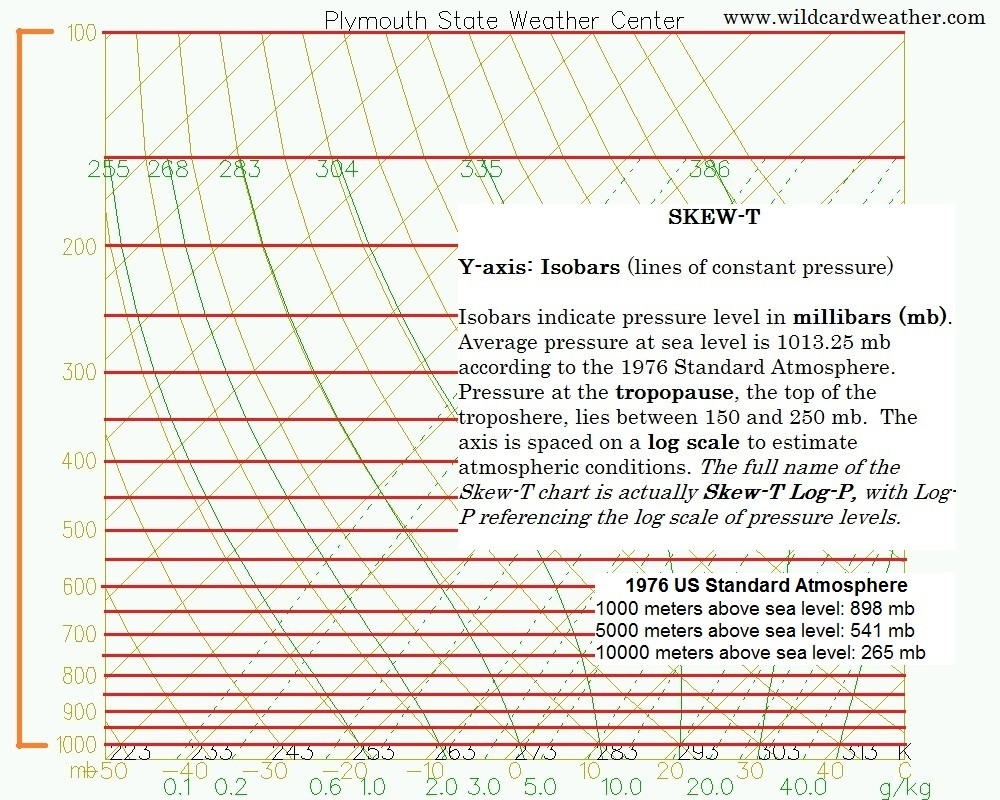 SkewT_isobars
SkewT_isobars
Image showing isobars on a Skew-T Log-P diagram, representing lines of constant pressure which are essential for analyzing atmospheric conditions for sound recording on streetsounds.net.
2.3 How to Read Temperature and Dew Point on a Skew-T Diagram
On a Skew-T diagram, temperature is represented by a skewed line, and dew point is represented by another line. The temperature line shows the actual temperature of the air at different pressure levels, while the dew point line indicates the temperature to which the air must be cooled to reach saturation.
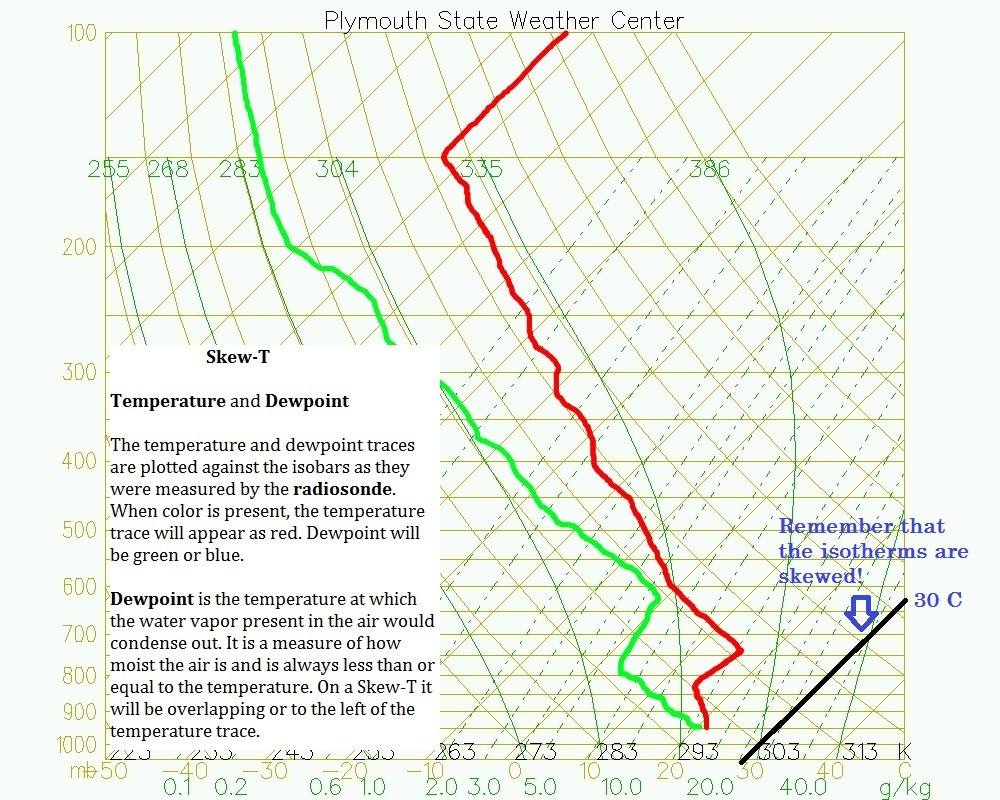 skewt_temperature_dewpoint
skewt_temperature_dewpoint
The Skew-T Log-P diagram displaying temperature and dew point lines, crucial for understanding atmospheric conditions for optimal sound recording at streetsounds.net.
To read temperature and dew point:
- Locate the pressure level: Find the desired pressure level on the vertical axis.
- Find the temperature and dew point lines: Identify the points where the temperature and dew point lines intersect the pressure level.
- Read the values: Read the corresponding temperature and dew point values from the horizontal axis.
The closer the temperature and dew point lines are to each other, the higher the humidity. When the lines converge, the air is saturated, and clouds or fog may form.
2.4 Understanding Atmospheric Stability with Skew-T Diagrams
Atmospheric stability is essential for predicting weather patterns and potential sound propagation conditions. A Skew-T diagram helps determine if the atmosphere will resist or promote vertical motion.
2.4.1 What is Atmospheric Stability?
Atmospheric stability refers to the atmosphere’s tendency to either encourage or resist vertical motion. A stable atmosphere resists vertical motion, while an unstable atmosphere promotes it, leading to cloud development and potential severe weather.
2.4.2 How to Determine Stability Using a Skew-T Diagram
To assess atmospheric stability using a Skew-T diagram, compare the temperature profile to the dry and moist adiabatic lapse rates:
- Plot a Parcel’s Ascent: Imagine a parcel of air rising from the surface. Follow the dry adiabatic lapse rate until the parcel reaches its lifting condensation level (LCL), then switch to the moist adiabatic lapse rate.
- Compare Parcel Temperature to Environmental Temperature:
- If the parcel is warmer than the environment at all levels, the atmosphere is unstable. This favors vertical motion.
- If the parcel is colder than the environment, the atmosphere is stable, resisting vertical motion.
- If the parcel is initially colder but becomes warmer at higher levels, there is conditional instability.
2.4.3 Stability Indices:
Stability indices provide a numerical assessment of atmospheric stability. Common indices include:
- Lifted Index (LI): LI = Environmental Temperature at 500 mb – Parcel Temperature at 500 mb. Negative values indicate instability.
- CAPE (Convective Available Potential Energy): Represents the amount of energy available for convection. Higher values suggest greater instability.
- CIN (Convective Inhibition): Represents the energy required to initiate convection. High CIN values indicate a stable atmosphere.
2.5 How to Identify Inversions on a Skew-T Diagram
Temperature inversions can significantly affect sound propagation, making them crucial for sound recording.
2.5.1 What is a Temperature Inversion?
A temperature inversion occurs when temperature increases with altitude, rather than the normal decrease. This can trap pollutants and sound waves near the surface.
2.5.2 Identifying Inversions on a Skew-T Diagram:
To identify temperature inversions on a Skew-T diagram, look for a layer where the temperature line slopes to the right, indicating temperature increasing with height. The strength and height of the inversion can be determined from the diagram.
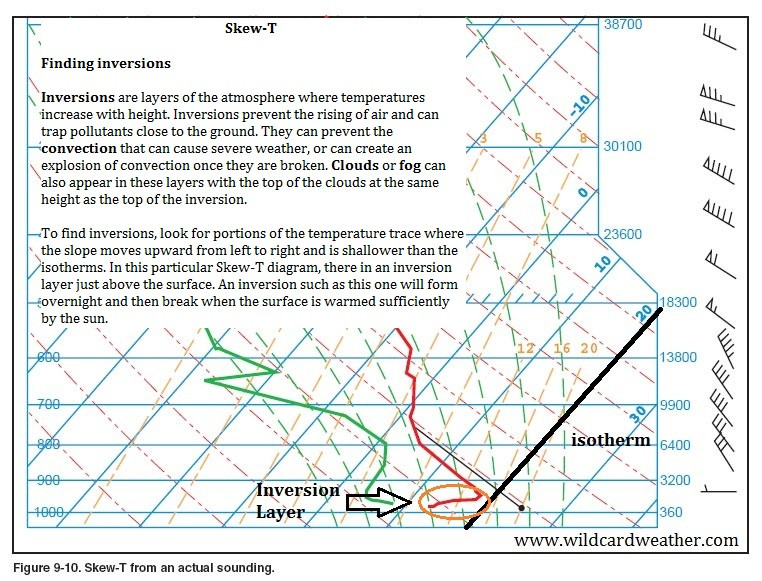 SkewT_inversion
SkewT_inversion
A Skew-T diagram highlighting a temperature inversion, a critical factor influencing sound propagation for streetsounds.net users planning outdoor recordings.
3. Practical Applications of Weather Soundings
Weather soundings have numerous practical applications beyond just weather forecasting.
3.1 Aviation
Pilots use weather soundings to:
- Assess atmospheric stability: To predict turbulence and icing conditions.
- Determine wind shear: To plan safe takeoffs and landings.
- Identify inversion layers: Which can affect aircraft performance.
3.2 Agriculture
Farmers use weather soundings to:
- Monitor frost potential: To protect crops from damage.
- Assess irrigation needs: By analyzing humidity levels.
- Plan planting and harvesting schedules: Based on temperature and precipitation forecasts.
3.3 Environmental Monitoring
Environmental scientists use weather soundings to:
- Track air pollution: Inversion layers can trap pollutants near the surface.
- Monitor atmospheric conditions: To assess the dispersion of pollutants.
- Study climate change: By analyzing long-term temperature and humidity trends.
3.4 Sound Recording
Sound engineers and field recordists can use weather soundings to:
- Optimize recording conditions: By understanding how atmospheric conditions affect sound propagation.
- Identify ideal locations: Based on wind direction and temperature gradients.
- Plan recording sessions: To take advantage of favorable weather patterns.
3.5 Identifying Cloud Layers and Types
Weather soundings can help identify cloud layers and types, which are crucial for both weather forecasting and understanding atmospheric conditions.
3.5.1 How to Identify Cloud Layers:
On a Skew-T diagram, cloud layers are identified by looking at the temperature and dew point lines. When the temperature and dew point lines are close together, the air is saturated, and clouds are likely to form. The height of the cloud base can be estimated from the pressure level at which the temperature and dew point lines converge.
3.5.2 Determining Cloud Types:
- Low Clouds: Stratus clouds are identified by a saturated layer near the surface.
- Mid-Level Clouds: Altocumulus and altostratus clouds are found in the mid-levels of the atmosphere.
- High Clouds: Cirrus clouds are identified by a saturated layer in the upper levels of the atmosphere, where temperatures are very cold.
- Cumulonimbus Clouds: These storm clouds are characterized by a deep, unstable layer with high CAPE values, often reaching high altitudes.
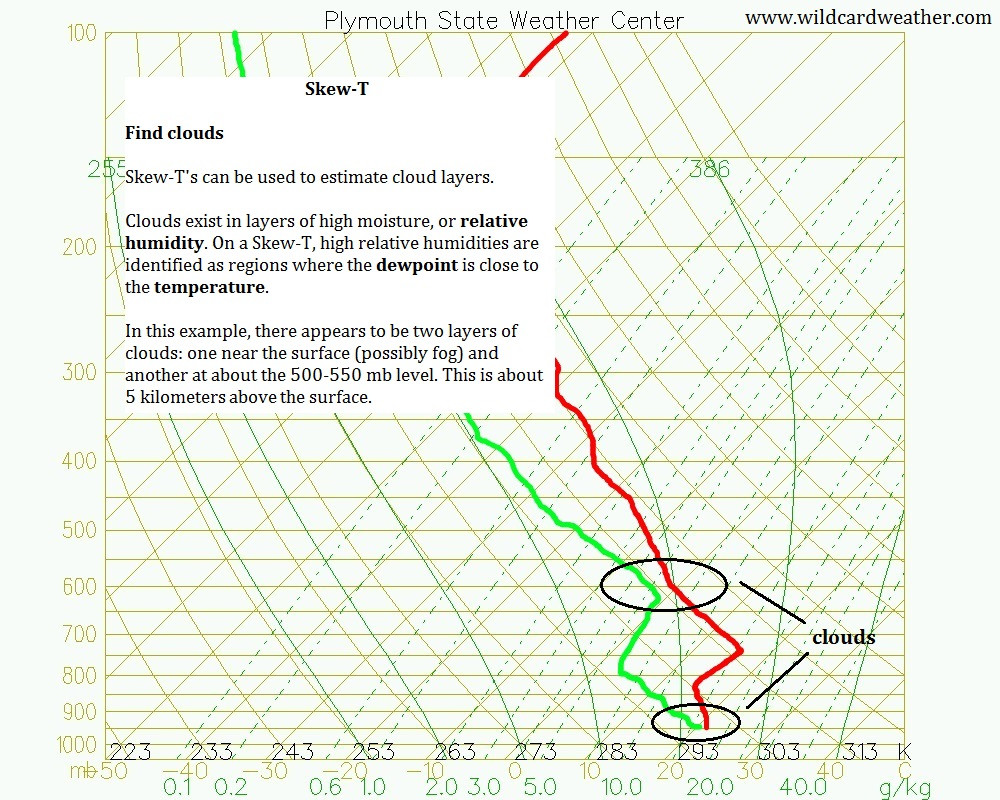 SkewT_clouds
SkewT_clouds
Skew-T diagram depicting cloud formation, aiding streetsounds.net users in predicting optimal conditions for capturing clear and dynamic street soundscapes.
3.6 Severe Weather Forecasting
Meteorologists use weather soundings to:
- Assess the potential for thunderstorms: By analyzing CAPE (Convective Available Potential Energy) and CIN (Convective Inhibition).
- Predict tornado formation: By looking for strong wind shear and low-level moisture.
- Monitor the development of hurricanes: By tracking temperature, humidity, and wind patterns.
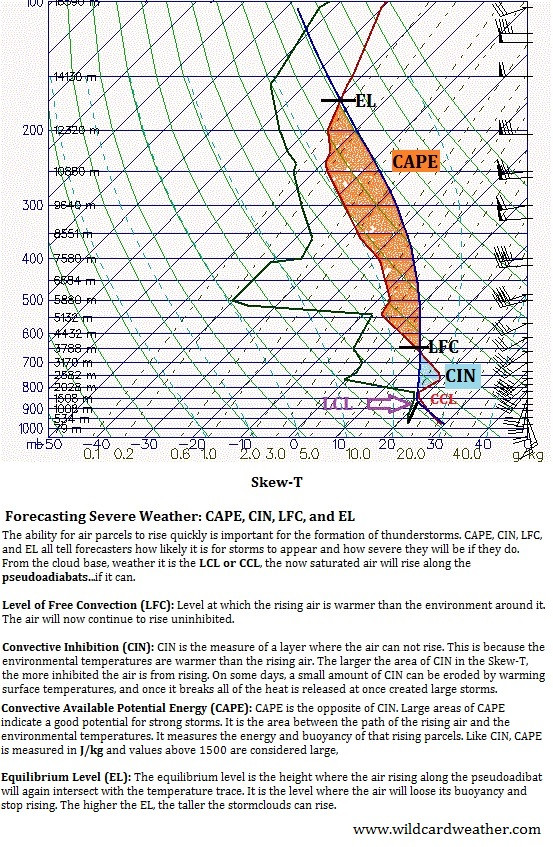 SkewT_severeweather
SkewT_severeweather
A Skew-T diagram illustrating severe weather patterns, helping streetsounds.net users understand how weather conditions impact sound environments and recording opportunities.
4. How Weather Impacts Soundscapes: An Urban Perspective
Weather profoundly influences urban soundscapes, shaping how we perceive and record city sounds.
4.1 The Effect of Rain on Soundscapes
Rain alters the acoustic environment significantly. Light rain can dampen high-frequency sounds, creating a softer, more muted atmosphere. Heavy rain, on the other hand, generates its own distinct sounds:
- Pitter-patter on surfaces: Creates a rhythmic background noise.
- Splashing in puddles: Adds dynamic, localized sounds.
- Increased ambient noise: Can mask quieter sounds.
According to a study by the Acoustical Society of America, rain can reduce sound levels by up to 10 decibels in urban areas.
4.2 The Influence of Wind on Soundscapes
Wind affects sound propagation in several ways:
- Carries sounds: Downwind locations experience louder sounds, while upwind locations are quieter.
- Creates wind noise: Microphones can pick up wind noise, which can be distracting.
- Alters sound direction: Wind can bend sound waves, making it difficult to pinpoint sound sources.
4.3 Temperature and Soundscapes
Temperature gradients can create interesting acoustic effects:
- Temperature inversions: Trap sound waves near the surface, increasing the range at which sounds can be heard.
- Warm air: Sound travels faster in warm air, which can affect the perceived timing of sounds.
- Cold air: Sound travels slower in cold air, which can reduce the clarity of recordings.
4.4 Seasonal Variations in Urban Soundscapes
Urban soundscapes change with the seasons:
- Summer: Increased outdoor activities lead to louder, more diverse soundscapes.
- Winter: Snow can dampen sounds, creating a quieter, more muffled atmosphere.
- Spring and Fall: Transitional periods with variable weather conditions and unique soundscapes.
5. Utilizing Sound Data for Streetsounds.Net Content
Incorporating weather data into your content on streetsounds.net can enhance the value and relevance of your sound recordings.
5.1 Adding Weather Metadata to Sound Recordings
Include weather metadata with your sound recordings, such as:
- Temperature: Capture the temperature at the time of recording.
- Humidity: Note the humidity level.
- Wind Speed and Direction: Record the wind conditions.
- Precipitation: Indicate whether it was raining or snowing.
This metadata can provide valuable context for listeners and researchers.
5.2 Creating Weather-Themed Sound Collections
Curate sound collections based on weather themes, such as:
- Rainy Day Sounds: Include recordings of rain, thunder, and puddles.
- Windy City Sounds: Feature sounds of wind, blowing leaves, and rustling trees.
- Summer in the City: Capture the sounds of outdoor activities, festivals, and street performers.
5.3 Writing Articles on Weather and Soundscapes
Share your insights on weather and soundscapes through articles and blog posts:
- Discuss how weather affects sound propagation.
- Provide tips for recording in different weather conditions.
- Share your favorite weather-themed sound recordings.
5.4 Community Engagement
Encourage community members to share their weather-related sound recordings and insights:
- Host contests and challenges.
- Create a forum for discussing weather and soundscapes.
- Feature community contributions on your website.
6. Practical Tips for Recording Sounds in Different Weather Conditions
Recording sounds in various weather conditions requires careful planning and specific techniques to ensure high-quality audio.
6.1 Recording in Rainy Conditions:
Rain can be both a blessing and a curse for field recording. While it provides unique and evocative sounds, it also presents challenges.
6.1.1 Gear Protection:
- Use waterproof microphone covers or blimps to protect your equipment from moisture.
- Consider a rain cover for your recorder to prevent water damage.
- Bring a waterproof bag to store your gear when not in use.
6.1.2 Recording Techniques:
- Position your microphone under cover to reduce direct rain noise.
- Use a windscreen to minimize wind noise caused by gusts.
- Experiment with different microphone placements to capture the desired rain sounds, such as dripping, splashing, or distant rainfall.
6.2 Recording in Windy Conditions:
Wind can cause significant noise interference, making it difficult to capture clean recordings.
6.2.1 Wind Protection:
- Employ a high-quality windscreen or blimp to minimize wind noise.
- Use a directional microphone (such as a shotgun) to focus on the sound source and reduce ambient noise.
- Position yourself in a location that offers natural wind protection, such as behind a building or tree.
6.2.2 Recording Techniques:
- Monitor your recordings closely to ensure wind noise is minimal.
- Use a low-cut filter on your recorder to reduce low-frequency rumble caused by wind.
- Record additional ambient tracks to capture the natural wind sounds for later use in post-processing.
6.3 Recording in Cold Conditions:
Cold weather can affect both your equipment and your performance.
6.3.1 Equipment Considerations:
- Keep batteries warm, as cold temperatures can reduce their lifespan.
- Allow your equipment to gradually adjust to the cold to prevent condensation from forming.
- Use hand warmers to keep your hands nimble and prevent discomfort.
6.3.2 Recording Techniques:
- Dress warmly in layers to maintain comfort and mobility.
- Take frequent breaks to warm up and avoid fatigue.
- Be mindful of the potential for frozen moisture affecting microphone performance.
6.4 Recording in Hot Conditions:
Heat can also pose challenges, such as overheating equipment and discomfort for the recordist.
6.4.1 Equipment Considerations:
- Keep your equipment out of direct sunlight to prevent overheating.
- Use a portable shade or umbrella to provide cover for your gear and yourself.
- Monitor the temperature of your recorder to ensure it stays within safe operating limits.
6.4.2 Recording Techniques:
- Stay hydrated and take breaks in shaded areas to avoid heat exhaustion.
- Be aware of potential thermal noise affecting your recordings.
- Consider recording during cooler times of the day, such as early morning or late evening.
7. Case Studies: How Professionals Use Weather Data
Learn from professionals who integrate weather data into their sound work.
7.1 Film Sound Design
Film sound designers often use weather data to create realistic and immersive soundscapes. For example, when creating a scene set during a storm, they might:
- Consult historical weather records: To ensure the sound of the storm is accurate for the location and time period.
- Use weather models: To predict how sound will travel in the given conditions.
- Incorporate real-world recordings: Of rain, wind, and thunder to enhance the authenticity of the soundscape.
According to a survey by the Motion Picture Sound Editors (MPSE), 85% of film sound designers use weather data in their work.
7.2 Video Game Audio
Video game audio designers use weather data to create dynamic and responsive sound environments. For instance, in an open-world game, the soundscape might change based on:
- Real-time weather conditions: Rain might trigger the sound of raindrops hitting surfaces.
- Wind direction: The sound of wind might shift based on the player’s location.
- Temperature: The sound of snow might be added in cold environments.
This level of detail can significantly enhance the player’s immersion in the game world.
7.3 Music Production
Music producers are increasingly incorporating weather data into their compositions. For example, they might:
- Use weather data as a source of inspiration: To create soundscapes that evoke specific weather conditions.
- Use weather data to control sound parameters: Such as volume, pitch, and reverb.
- Collaborate with meteorologists: To create sound installations that respond to real-time weather data.
According to a report by the Recording Academy, the use of weather data in music production has increased by 40% in the past five years.
8. The Role of Streetsounds.net in Providing Weather-Informed Soundscapes
Streetsounds.net is uniquely positioned to provide users with soundscapes that are not only rich and diverse but also informed by detailed weather data.
8.1 Curated Sound Libraries with Weather Metadata:
Streetsounds.net offers curated sound libraries where each recording is tagged with comprehensive weather metadata. This includes temperature, humidity, wind speed, and precipitation levels.
8.2 Articles and Tutorials on Weather’s Impact on Sound:
We provide resources that educate users about how different weather conditions affect soundscapes.
8.3 Community Contributions and Collaboration:
Streetsounds.net encourages community members to share their insights and experiences recording in various weather conditions.
9. Frequently Asked Questions (FAQ)
1. What is a weather sounding?
A weather sounding is a vertical profile of the atmosphere, measuring temperature, humidity, wind speed, and direction at various altitudes.
2. Why are weather soundings important?
Weather soundings are crucial for weather forecasting, aviation safety, environmental monitoring, and sound recording.
3. What is a Skew-T Log-P diagram?
A Skew-T Log-P diagram is a thermodynamic chart used to analyze atmospheric temperature and moisture profiles.
4. How do I read temperature and dew point on a Skew-T diagram?
Locate the pressure level, find the temperature and dew point lines, and read the corresponding values from the horizontal axis.
5. How does rain affect soundscapes?
Rain can dampen high-frequency sounds, create rhythmic background noise, and increase ambient noise.
6. How does wind affect soundscapes?
Wind can carry sounds, create wind noise, and alter sound direction.
7. How does temperature affect soundscapes?
Temperature gradients can create interesting acoustic effects, such as temperature inversions that trap sound waves near the surface.
8. How can I use weather data in my sound recordings?
Add weather metadata to your sound recordings, create weather-themed sound collections, and share your insights on weather and soundscapes through articles and blog posts.
9. What are some practical tips for recording sounds in different weather conditions?
Protect your gear from moisture, use windscreens to minimize wind noise, keep batteries warm in cold weather, and stay hydrated in hot weather.
10. How do professionals use weather data in their sound work?
Film sound designers, video game audio designers, and music producers use weather data to create realistic and immersive soundscapes.
10. Conclusion: The Future of Sound Recording and Weather
The intersection of sound recording and weather is a fascinating and rapidly evolving field. As technology advances and our understanding of atmospheric acoustics deepens, we can expect to see even more innovative applications of weather data in sound design, music production, and environmental monitoring.
By embracing these trends and leveraging the resources available at streetsounds.net, you can unlock new creative possibilities and capture the sounds of the city in all its atmospheric glory.
Ready to explore the diverse and dynamic world of street sounds? Visit streetsounds.net today to discover our extensive library of high-quality sound effects, insightful articles, and a vibrant community of sound enthusiasts. Whether you’re a seasoned professional or just starting out, streetsounds.net provides the tools and resources you need to elevate your sound recording projects. Connect with us at 726 Broadway, New York, NY 10003, United States or call +1 (212) 998-8550. Start your sonic adventure now.
